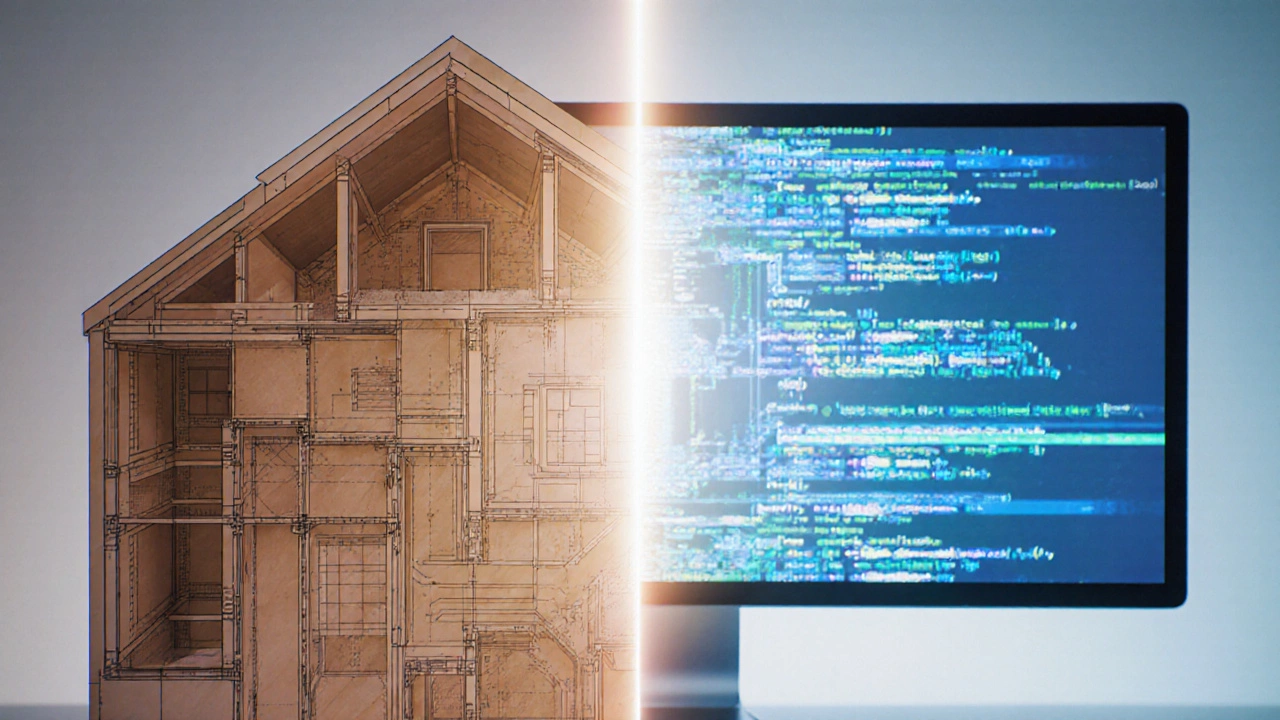Programming vs Coding Learning Path Planner
Coding First
Start with writing code to build confidence quickly. Great for immediate results and hands-on learning.
Programming First
Begin with problem-solving and design concepts. Ideal for understanding how software works at a deeper level.
Your Recommended Learning Path
Ever found yourself scrolling through endless articles wondering whether to dive into programming vs coding first? You’re not alone. The terms get tossed around like synonyms, but the reality is a bit richer. In this guide we’ll untangle the concepts, look at what each path offers, and give you a clear plan so you can start building useful skills right away.
Key Takeaways
- Programming is a broader discipline that focuses on solving problems by designing algorithms and structuring software.
- Coding is the act of translating those designs into syntax that a computer understands.
- Start with coding if you need quick wins, but pair it with programming fundamentals for long‑term growth.
- Both tracks share core skills like logic, problem‑solving, and familiarity with development tools.
- Your career choice (web development, data science, embedded systems, etc.) will guide which skill set to prioritize early on.
What Exactly Is Programming?
Programming is a systematic approach to creating software solutions. It starts with defining the problem, breaking it into logical steps, and then designing an algorithm that a machine can execute. Think of it as the blueprint of a house - you decide where the rooms go, how the wiring runs, and what materials to use before any nail is hammered.
Key attributes of programming include abstraction (hiding low‑level details), modularity (splitting code into reusable blocks), and scalability (building systems that can grow). Languages like Python, Java, and C++ each offer different abstractions, but the underlying principles stay the same.
What Exactly Is Coding?
Coding is the hands‑on activity of writing source code that follows a language’s syntax rules. It’s where you transform the algorithm from the programming phase into concrete statements - variables, loops, conditionals, and function calls.
Coding feels a lot like writing a recipe: you list ingredients (variables), specify actions (functions), and set the order of steps (control flow). The main goal is to produce a working program that does what the design intended.

Scope and Abstraction: How They Differ
While both activities involve a computer, the level of abstraction is where they split. Programming works at the logical level, focusing on *what* needs to happen. Coding lives at the syntactic level, focusing on *how* it happens.
For example, a programmer might decide that an e‑commerce site needs a “shopping cart” feature that can hold unlimited items. The coder then writes the exact code - classes, methods, and database queries - to make that feature functional.
Skills Overlap: The Shared DNA
Both programming and coding require a solid grasp of Algorithmic thinking, logical reasoning, and familiarity with development environments (IDEs, version control, debugging tools). These shared skills form the backbone of any Software Development career.
In practice, beginners often learn to code first because it provides immediate feedback - you write a line, run it, see it work (or crash). That quick loop reinforces confidence and builds the habit of troubleshooting, which is essential when you later step into higher‑level programming tasks.
Learning Paths - Where to Start?
If you’re itching for a fast start, pick a beginner‑friendly language like Python. Its syntax is clean, its community is huge, and you can write functional scripts after a few hours. This gives you a taste of coding without drowning you in complex type systems.
Once you’re comfortable writing simple scripts, broaden your horizon:
- Study Core Concepts: Variables, data types, control structures, functions, and basic OOP (object‑oriented programming).
- Learn Algorithms and Data Structures: Lists, stacks, queues, and simple sorting/searching algorithms. These are the building blocks of good programming.
- Explore System Design Basics: How components talk, APIs, and scalability concerns. This is pure programming territory.
- Build Projects: Start with a tiny web app or a small automation script, then gradually increase complexity.
By alternating coding practice with programming theory, you avoid the “coder‑only” trap where you can write code but struggle to design larger systems.

Career Impact: Which Choice Pays Off More?
Employers look for both: the ability to write clean code and the capacity to architect solutions. In roles like Full‑Stack Development, you’ll be expected to handle everything from UI markup (coding) to backend logic (programming). In contrast, a Data Analyst may need strong coding skills for scripting but less deep programming architecture.
Salary surveys from 2024 show that professionals who can both design algorithms and implement them command roughly 12‑15% higher average salaries than those who focus solely on one side. The key is to demonstrate competence in both during interviews - explain your design decisions, then walk through the code that made them happen.
Practical Tips for Beginners
- Pick one language, master its basics. Switching too often stalls progress.
- Write daily. Even a 15‑minute script builds muscle memory.
- Read code. Open‑source projects reveal how seasoned programmers structure programs.
- Use version control (Git). It teaches disciplined coding habits early.
- Ask “why” before “how”. When you encounter a new library, understand the problem it solves before you copy the code.
Programming vs Coding: Side‑by‑Side Comparison
| Aspect | Programming | Coding |
|---|---|---|
| Focus | Problem definition & algorithm design | Translating design into syntax |
| Abstraction Level | High (conceptual) | Low (syntactic) |
| Typical Tasks | Flowcharts, pseudo‑code, system architecture | Writing functions, fixing bugs, refactoring |
| Learning Curve | Steeper - requires logic & math basics | Gentler - immediate results |
| Career Roles | Software architect, algorithm engineer, backend lead | Front‑end developer, junior programmer, script writer |
| Impact on Salary | Higher on average (design expertise) | Solid - can grow with experience |
Frequently Asked Questions
Is coding the same as programming?
No. Coding is the act of writing code in a specific language, while programming encompasses the broader process of designing solutions, choosing algorithms, and structuring software.
Should I learn coding before programming?
For most beginners, starting with coding gives quick feedback and builds confidence. Once you’re comfortable, layer in programming concepts like algorithms and system design.
What language is best for a beginner?
Python is widely recommended because its syntax is clean and it’s used in many domains-from web apps to data science.
Can I become a software engineer by only learning to code?
You can get an entry‑level job, but advancing to senior roles usually requires strong programming fundamentals, such as algorithmic thinking and architectural design.
How long does it take to master programming?
Mastery is a journey, not a destination. Consistent practice over 2‑3 years can make you proficient enough to handle complex projects, but learning never truly stops.
